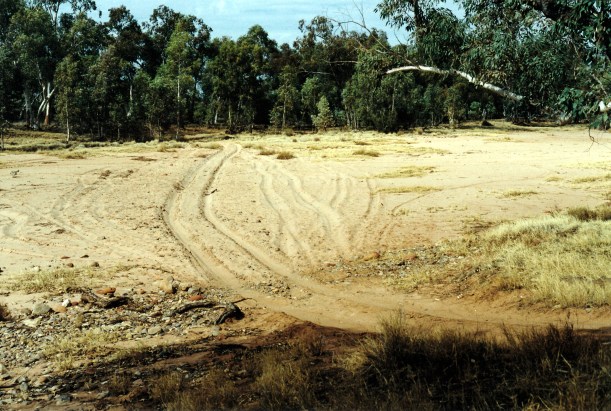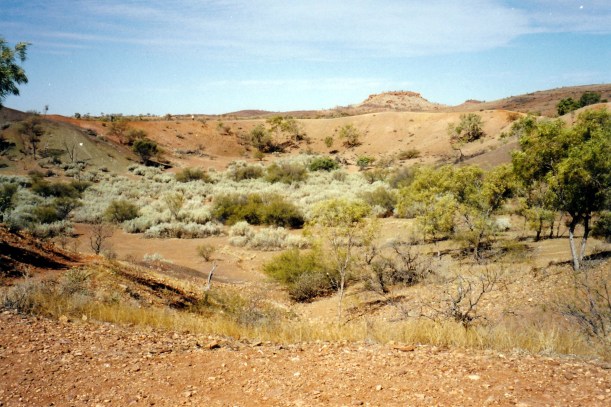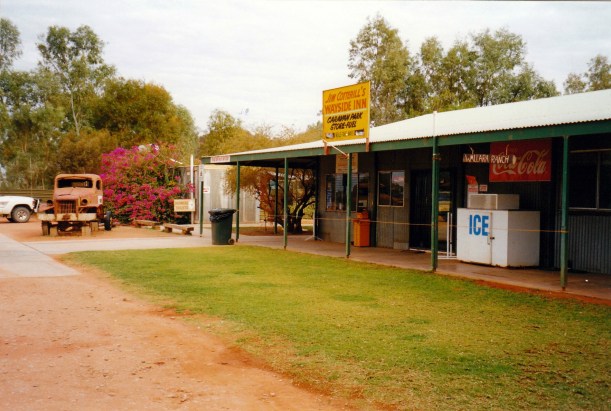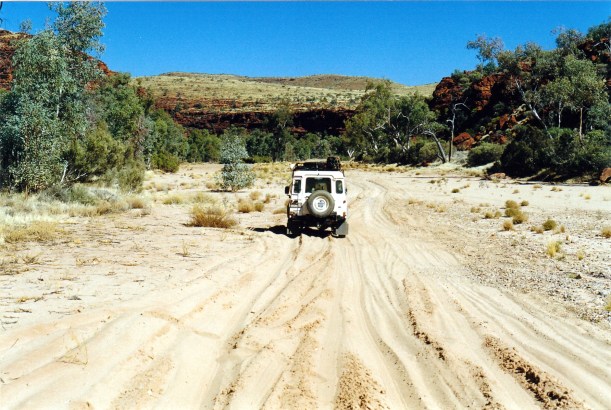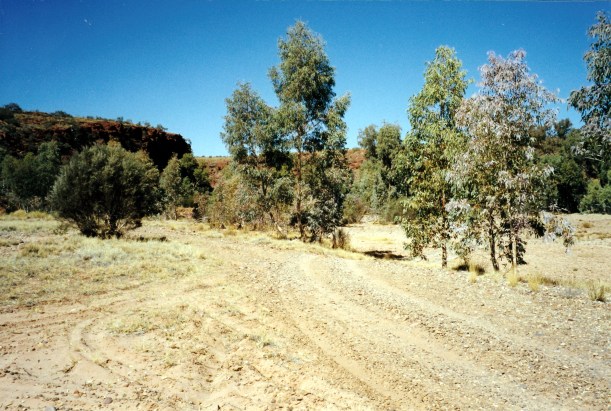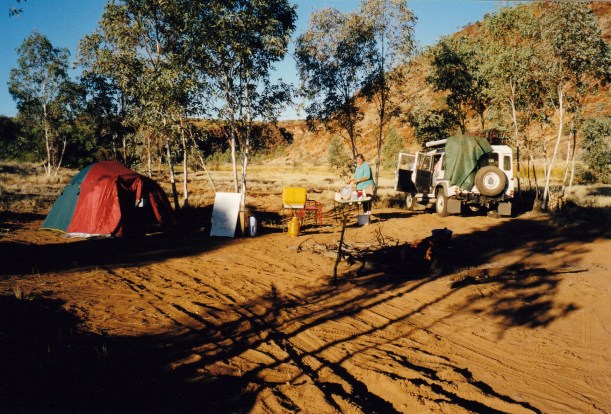FRIDAY 13 AUGUST CHAMBERS PILLAR TO MT DARE HOMESTEAD 311kms
We woke up at 7am. The night had been a bit too chilly and the lilo not comfortable enough to sleep well.
Again, it took us nearly two hours to breakfast and pack up.
It was a lovely clear day, but cool – I kept my windcheater on all day.
The route back to Maryvale seemed easier than it had yesterday. The fact of having driven it once turns it from the unknown to the more familiar. At Maryvale we bought Mars Bars, bottles of cold water and fuel – 98cpl.
Then we went back the way we’d come, yesterday, as far as the Rodinga Siding ruins, on the Old Ghan rail route. We stopped there, to put up a makeshift sand flag on Truck. John had pre-planned the construction of this, using the broken CB radio aerial and a bright pink piece of rag, from his stock of same; it had once been a T shirt. He tied the lot firmly to the roof rack. Quite effective and cheaper than buying a proper one. Sand flags are mandatory in the coming sand dune country, to give approaching vehicles some advance notice of one’s presence.

At Rodinga ruins, flying our new sand flag
Then it was onto the Old Ghan Track, heading south for Finke. At the start of this section, driving on the old rail alignment was a novelty, and we mixed road tracks and old rail alignment. But by the time we reached Finke, we had in fact, travelled most of the way on the rail alignment. It was much smoother than the road tracks, the latter having been used not long ago, for the Finke Desert Race, and really churned up. However, some track sections did appear to have been recently bladed.

The churned up road track

On the Old Ghan Track, with the alternate road beside it
The problem with the rail route was that there were lots of big metal spikes, once used to anchor the sleepers, still lying about, and these are risky for tyres. But we preferred to chance that, rather than get bogged, or break something, on the road tracks.
The countryside we travelled through today was mixed – some red sand dune country, some flat-topped mesa country, some river plains and flats, gibber stone plains in the south – some country similar to that around Oodnadatta. So it was a day of considerable variety.
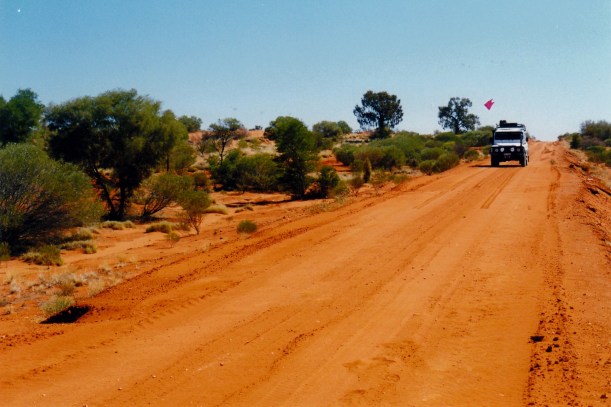
Red sand dune country
The first section, from Rodinga to Finke, had lots of arrow signs and X markers, relating to the Desert Race.
Just as on the southern section of the Old Ghan Track, that we’d tackled earlier in the year, there were the ruins of former sidings, at regular intervals.
We stopped to have our lunch at the historic Alice Well, by the crossing of the dry Hugh River bed. There are some stone building remains there – what is left of the former Government Depot and Police Station.

What was left of the old Government Deopt at Alice Well
I had the lunch makings of Ryvita biscuits, cheese, vegemite, in the picnic basket and the fridge – which John had made sure was accessible easily. The fridge does not run while we are travelling, but the theory is that the contents stay cold through the day, anyway. The chill breeze, flies and dust dictated that I prepared the food in the passenger side footwell of Truck. It is actually quite convenient.
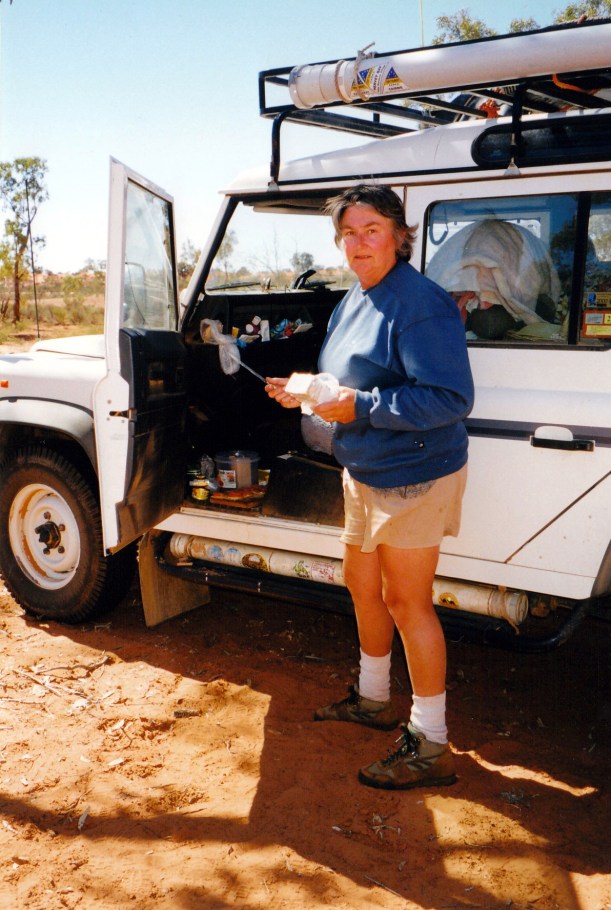
Making lunch by the side of the track
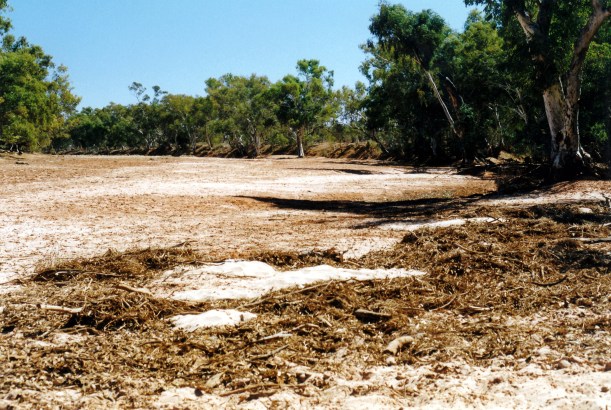
The bed of the Hugh River at Alice Well
Next we stopped to have a look around the remains of the old Bundooma Siding. There is not much left there now. There were some foundations and the old water tank on its stand.

The reamins at Bundooma Siding
At Engoordina Siding there were remains of the fettlers’ accommodation – really close to the rail alignment.

Engoordina Siding ruins – very close to the rail alignment
I took a photo of Colsons Pinnacle at a point where there was a good view of it in the distance. This is somewhat similar to Chambers Pillar – another erosion feature and a landmark for earlier explorers and travellers, because of its distinctive shape. It was also known as the Maiden’s Breast! It, and the surrounding mesas, are two toned, with alternating layers of light and dark rock. The horizontal line of separation of these is so straight it could have been drawn with a ruler.

Colsons Pinnacle
I drove for some of the way, each side of Finke.
The river bed at Finke was wide, sandy and churned up, but we ploughed through fairly easily.

Our old friend, the Finke River
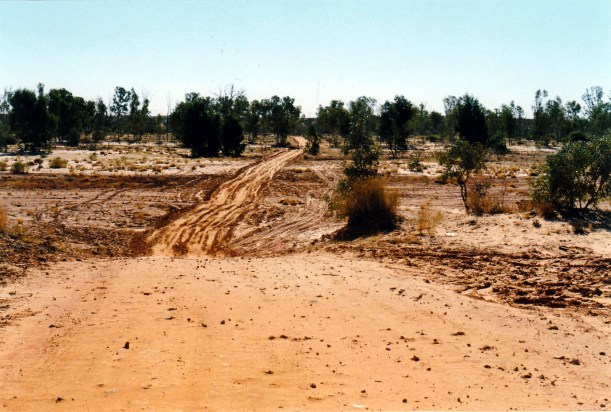
The track through the river bed at Finke
After Finke, we left the old rail route, and headed more to the west and south west, on dirt roads and station tracks. It was stony country now, and more monotonous as the mesa country was left behind. There was almost no other traffic. There were gates to open and close, of course. Landmarks that reassured us that we were going the right way – very few signposts! – were New Crown Homestead, Charlotte Well, then crossing from the NT into SA.

Going around a section of bad bulldust on the Finke to Mt Dare track
The waypoints that John put into the GPS yesterday, were mostly right and were an extra reassurance. However, we did go the wrong way for a short distance, south of Charlotte Well, where there were several tracks. It was a good thing that I was navigating, as well, and had my Westprint map, and realised we were on the Abminga track, not the one we wanted to Mt Dare.
We reached Mt Dare – homestead, hotel, campground – about 4pm. There was no one else in the campground. The man obligingly opened the bar, so we could each have a beer! To camp cost us $5 each, the beer was $3.50 each. John bought a cask of riesling that he saw there – $25! He’d asked for it before he knew the price.
The camp area was alright. Some bushes for shelter, bare dirt – as one would expect out here. They lit the hot water “service” for our showers – made out of an old, tall, LPG cylinder – ingenious. We enjoyed that shower, too.

Our Mt Dare camp – with visitng willy wagtail
By sunset, there were lots of galahs in distant trees and they squawked on and off, well into the night.
The fridge was set up on gas, again. It is working, but does not seem to be cooling as quickly or as much as usual.
Tea: mushroom soup from a packet, with dried milk powder used to make milk for it. Then fettucine, with a bottled tomato sauce.
After the radio sched, John did work on tomorrow’s waypoints to take us to Dalhousie Springs. I wrote up the diary and some cards.
It was quite a chilly night, so we did not sit up too long.

From Chambers Pillar to Mt Dare





